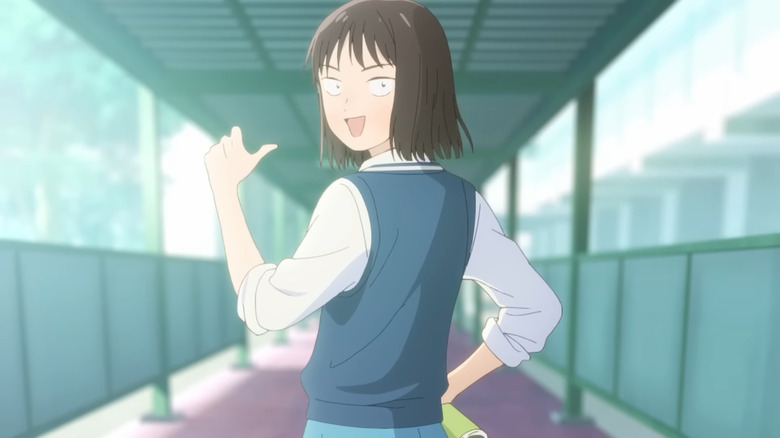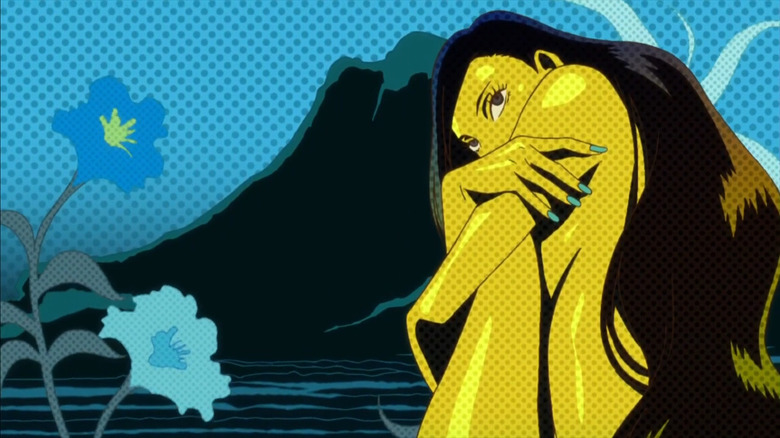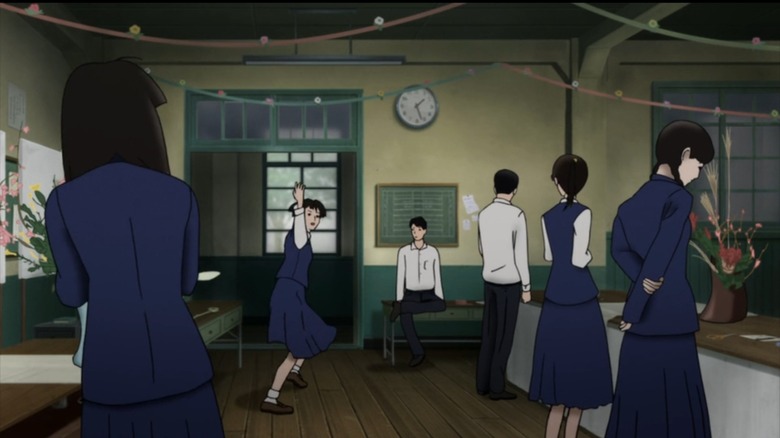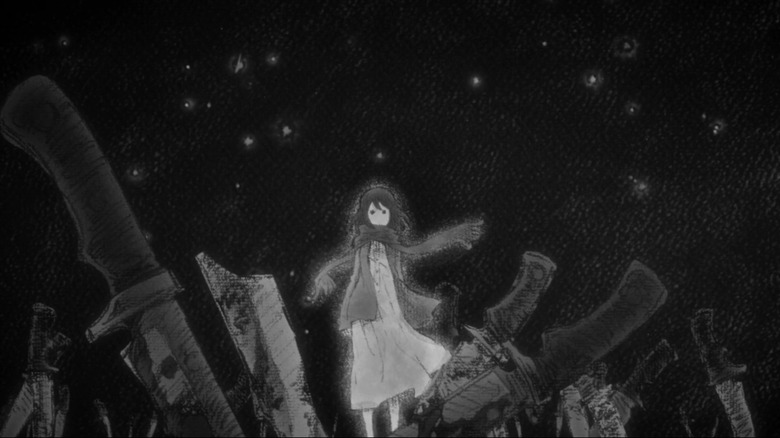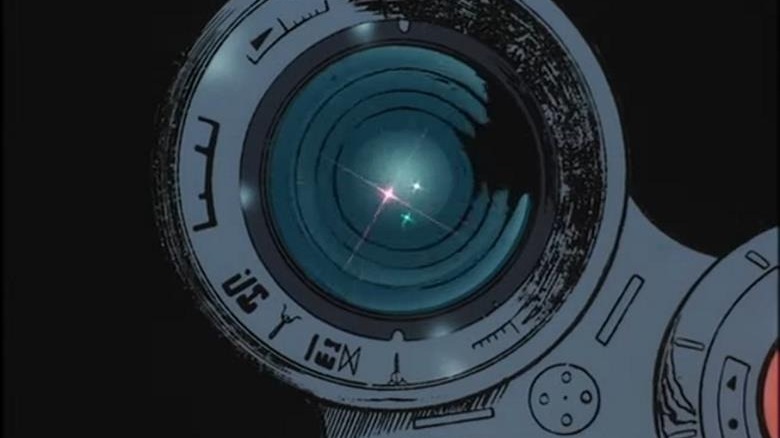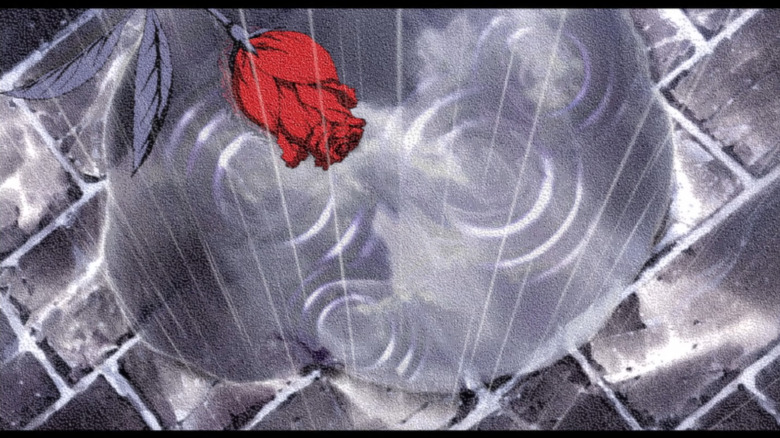How The Director Of Cowboy Bebop Inspired Others To Change The Anime Industry
The one anime series that I'm most excited about this spring is "Skip and Loafer." The source manga tells the tale of Mitsumi Iwakura, an ambitious teenage girl from the country who moves to Tokyo for high school. There she meets the easygoing Sosuke Shima, and the two of them slowly build a close-knit network of friends that includes local mean girl Mika Egashira, bookish Makoto Kurame, and independent-minded Yuzuki Murashige. Each of them is as different as can be, and yet despite bad early impressions, they find a common cause in each other. "Skip and Loafer" is too good-natured to be a "realistic" high school story. But it is successful at evoking the texture of adolescence in its banality, complexity, and sweetness.
"Skip and Loafer" is also the first anime in years to be directed and scripted by the great Kotomi Deai, who has now been active in the industry for at least two decades. Her first original series, "The Rolling Girls," was a flawed but fascinating mash-up of electrifying action, road trip shenanigans, and the famed Japanese punk band The Blue Hearts. "Skip and Loafer" is unmistakably her next big play as a director and artist.
Of course, a name is just a name. Why follow the career of someone like Deai, you might ask, when you could be tuning into the next big property from global hitmaker Shonen Jump? "Skip and Loafer" may not do "Chainsaw Man" numbers. But Deai is undeniably skilled, even though the notoriously sexist anime industry has rarely given her opportunities commensurate with her experience. Just ask her mentor, "Cowboy Bebop" director Shinichirō Watanabe.
Linda Linda
In 2012, Kotomi Deai worked alongside Shinichirō Watanabe on the drama series "Kids on the Slope." The series was Watanabe's first as a director since 2004's "Samurai Champloo," and his first adaptation. Deai is credited with directing and providing storyboards for the penultimate eleventh episode. She also directed the first and seventh episodes and is credited as assistant director on episodes 6, 9, 10, and 12. Deai undoubtedly had the most influence on the eleventh episode, but the degree to which she contributed behind the scenes distinguished her even among the many other talented storyboarders and animators who contributed to the project.
Watanabe and Deai have had very different careers. Watanabe is a producer and remixer who frequently scouts talent from outside the anime industry. Aside from "Kids on the Slope," the majority of his work has been original projects. Kotomi Deai by contrast has specialized in adaptation, directing well-liked seasons of slice-of-life shows like "Silver Spoon" (based on a comic by "Fullmetal Alchemist" creator Hiromu Arakawa) and "Natsume's Book of Friends." "Skip and Loafer" fits the easy-going spirit of these earlier projects.
But it's "The Rolling Girls," as an original series, that best demonstrates what priorities Deai shares with Watanabe. The action of "Rolling Girls" is scored to covers of Blue Hearts songs by female vocalists, remaking the band's output in the image of the show's cast of characters. Just like Watanabe, a famous music geek, Deai knew exactly what music to pick in order to define her show's worldview.
History maker
Four years before "Kids on the Slope," Kotomi Deai contributed storyboards to a 2008 series called "Michiko & Hatchin." The show was directed by Sayo Yamamoto, another Shinichirō Watanabe protege. Yamamoto is best known today for "Yuri!!! on Ice," an ice-skating drama so beloved that it inspired routines at the Olympics. At the time of "Michiko & Hatchin" though, Yamamoto was still figuring out who she wanted to be. Per a 2017 Febri interview (translated by Tora) at Wave Motion Cannon, she began her career at Madhouse in 2000 as a production assistant. Madhouse at the time was a playground for up-and-coming directors like Tetsuro Araki of "Death Note" fame.
But Yamamoto never felt at home there. "In my third year at the company," she said, "I thought that if I stayed there as an employee, I would never be able to choose my work and might not be able to improve." When Watanabe reached out to ask if she would join his new series "Samurai Champloo" at Manglobe, Yamamoto jumped ship and never looked back. She storyboarded four episodes of "Champloo," more than anybody other than Kazuyoshi Katayama and Watanabe himself.
Yamamoto had to fight at every step of her career to make what she wanted. When the CEO of Manglobe envisioned "Michiko & Hatchin" as a female-led action series, it was Yamamoto who instead centered the messy relationship between the two leads. When a producer at TMS Entertainment asked that she create a gritty "Lupin the Third" series, it was Yamamoto who turned the camera from Lupin himself to femme fatale Fujiko Mine. Along the way, she continued trading favors with Watanabe. He produced the music for "Michiko & Hatchin," and she paid him back with the ending credits sequence for Watanabe's experimental comedy "Space Dandy."
Moanin'
Shinichirō Watanabe isn't just known for scouting directors, but animators as well. Bahi JD is an Austrian animator who honed his skills by posting GIFs on fan forums. An early example of his work is 2009's "S***HEAD ACTION," which has since been memorialized on YouTube. According to an interview at Otaquest, he pitched his portfolio to anime studios only to be turned down again and again.
It wasn't until experienced animator and character designer Cindy Yamauchi vouched for his work that Watanabe hired Bahi to draw for the seventh episode of "Kids on the Slope." In it, the two protagonists repair their relationship in an explosive jazz performance that attracts everyone in their school. Kou Matsuo and director Kotomi Deai deserve credit for their storyboards and episode direction, respectively. But it was Bahi's animation of excited students waving over their peers, promising something truly incredible, that made the episode the masterpiece that it is.
Bahi JD has since been part of several Watanabe projects, including "Space Dandy" and "Blade Runner: Black Out 2022." Perhaps his best work is the opening credits for 2019's "Carole & Tuesday." Bahi had previously handled the opening for "Atom: The Beginning" alongside industry luminaries like Mitsuo Iso and Hakuyu Go. This experience gave Watanabe, along with the show's director Motonobu Hori, the confidence to recruit him for their show. Per a SakugaBlog interview, the opening credits to "Carole & Tuesday" integrated the work of "Coraline" concept artist Tadahiro Uesugi with Kyoto artist Jun Kumaori. It's a beautiful, finely detailed sequence that features evocative setting work and robust character animation.
Credit where credit is due
As it happens, Kotomi Deai and Sayo Yamamoto are also both opening and ending credits friends. Yamamoto especially is one of my all-time favorites. The filthy monochrome of the "Psycho-Pass" opening credits, the melancholy first "Attack on Titan" ending sequence, and even the rebellious figure skating of the "Persona 5" opening movie are all her creations. Deai is no slouch either. I'm particularly impressed by her opening credits for "The Great Pretender," which riff on Steven Spielberg's "Catch Me If You Can". Even her quieter work features the bright colors and exuberance that have defined her career. It's no surprise that Shinichirō Watanabe, whose anime productions include some of the best opening and ending credits sequences ever made, was drawn to these artists.
Even so, it's undeniable that Deai and Yamamoto have faced professional challenges throughout their careers that Bahi JD and Watanabe have avoided. "The Rolling Girls" may have been a mess, but that had as much to do with Wit Studio's famously terrible management in its early days as it did with Deai's leadership. There's no reason why Deai had to be marooned in director jail for eight years, save for credits sequences and two seasons of "Natsume's Book of Friends." Meanwhile, the film follow-up to "Yuri!!! on Ice" has been stuck in development hell since its announcement in 2019. Only a 2020 update from writer and artist Mitsurou Kubo implies that the project is still being developed. Over the years, MAPPA has evolved from developing ambitious original anime to expensive Shonen Jump hits. Perhaps Yamamoto is once more fighting behind the scenes, this time to ensure her team's baby isn't abandoned by a famously mercenary CEO.
T-shirt and jeans
Just as "comics will break your heart," the anime industry can be an unfriendly place. Up-and-coming animators are offered the "poisoned gift" of an animation credit by "desperate" production assistants who will hire anybody that can draw. The fruit of their labors is, more often than not, dismissed as unsalvageable and entirely redrawn by desperate artists behind the scenes. Some have blamed these young animators for jumping into an exploitative industry without the basic skills they need to survive. But everybody starts somewhere. The industry needs staff who don't just have an eye for talent but will stay with that talent to ensure they blossom into the best possible artists.
Shinichirō Watanabe was young once, too. He spoke in a Forbes interview back in January about his experience applying for a job at the anime studio Sunrise. "I assumed it was a fairly casual type of industry, so I turned up in a T-shirt and some jeans," he said. "Whereas everyone else was in a suit, which was a bit of a shock."
Watanabe goes on to say how two of the three interviewers didn't seem to know what to make of him. But the third was Ryousuke Takahashi, the director of 1983's realistic mecha series "Armored Trooper VOTOMS." "I only found out later that Takahashi had vouched for me after the interview," Watanabe said. He still fondly remembers Takahashi's leadership as well as drinking with fellow "movie buffs" after work.
It stood in stark contrast to the chaotic management of "Gundam" director Yoshiyuki Tomino elsewhere at Sunrise. Bahi JD told SakugaBlog that Watanabe was "really good at creating a balanced environment during work [and he stayed] very calm in the most troublesome situations." Watanabe may have very well been following Takahashi's example.
Small hopes and favors
It wasn't enough that Shinichirō Watanabe found creative success through the intervention of Ryousuke Takahashi, as well as his own efforts. He took it upon himself to hold open the door so that others could walk through. So it was that folks like Bahi JD, Sayo Yamamoto, and Kotomi Deai were given the chance to make their mark in the anime industry. Not just to fulfill the artistic dreams of others, but to learn what they themselves wanted to create.
This same process has repeated itself again and again throughout the medium's history. In the best-case scenario, such as with Watanabe, the student and teacher learn from each other throughout their respective careers. In other cases, such as at the famous Studio Ghibli, students and teachers cannot coexist. The young artists leave the old to wither.
I'm convinced that we have not yet seen Kotomi Deai's full potential as a director. "Skip and Loafer" may represent that opportunity at last. Or it might not. "It can take years to understand an anime director," SakugaBlog contributor Kevin Cirugeda said, "and sometimes we never do."
To watch anime as it airs is to hope that talent and hard work behind the scenes will overcome the forces of entropy asphyxiating the medium. Seven times out of ten, entropy triumphs. But you hope against hope every time that a chain of small favors reaching back years may finally pay off. These chains run through history, binding the fates of artists and professionals young and old. Without them, the anime industry would have died long ago.
